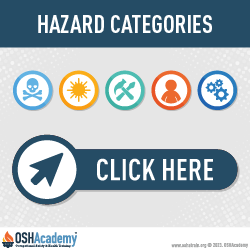Identifying Hazards
The employer is responsible for identifying hazards. It's useful to categorize them into five categories:
- The first three categories (materials, the environment, and equipment) represent hazardous conditions. Hazardous conditions are the surface causes that directly account for only a small percentage of all workplace accidents.
- The fourth category (people) describes employee behaviors. Employee behaviors represent the surface causes that contribute to or cause a higher percentage of workplace accidents.
- The fifth category (system), identifies safety management systems weaknesses. They are the root causes that ultimately contribute to or cause most accidents.
Click on the buttons below to see examples in each MEEPS category.
- Liquid and solid chemicals (such as acids, bases, solvents, explosives, etc.) can produce harmful effects.
- Raw materials (solids like metal, wood, and plastic) used to manufacture products are usually bought in large quantities and can cause injuries or fatalities in many ways.
- Gases, like hydrogen sulfide and methane, may be extremely hazardous if leaked into the atmosphere.
- Poor facility and workstation design might create serious ergonomic challenges.
- Hazardous indoor/outdoor environments include extreme temperatures, noise, humidity, and contaminants.
- A unhealthful psychosocial environment in the workplace can create stress, low morale, and potentially instances of aggression or workplace violence.
- Hazardous equipment that is improperly guarded and places workers in a danger zone around moving parts could cause injury or death.
- Lack-of a preventive and corrective maintenance program can make it difficult to ensure equipment operates properly.
- Tools that are defective, not suitable for workers, improperly repaired, or not used for their intended purpose are accidents just waiting to happen.
- Employees take unsafe short cuts because they think their way of doing things is better.
- Employees fail to use personal protective equipment because they think it's unnecessary.
- Employees are working while fatigued, ill, or under of influences of drugs or alcohol.
- Employees are distracted from focusing on the work they are performing.
Ultimately, the root cause of most accidents is one or more weaknesses within the safety management system that contribute in some way to the surface cause hazards and unsafe behaviors in the workplace.
- Management does not integrate safety topics in planning and budget meetings.
- Safety performance is not included in employee performance appraisals.
- Safety committees are not established and active in performing duties.
Knowledge Check Choose the best answer for the question.
1-5. Which of the following MEEPS hazard categories includes root causes and ultimately is the result of most accidents?
You forgot to answer the question!

